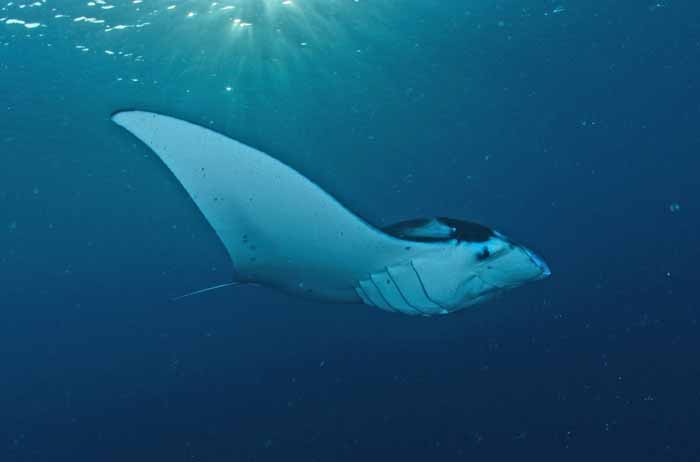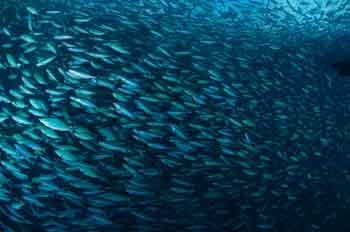Manta Ray
by wjw on November 2, 2016
 It’s always been my ambition to view a manta ray, or devilfish, though luck has always been against me. One of the best places in the world to see a manta is the German Channel in Palau, a channel in the reef blasted by German engineers in support of their phosphate mining endeavors, back when the islands belonged to Wilhelm II.
It’s always been my ambition to view a manta ray, or devilfish, though luck has always been against me. One of the best places in the world to see a manta is the German Channel in Palau, a channel in the reef blasted by German engineers in support of their phosphate mining endeavors, back when the islands belonged to Wilhelm II.
When the tide is on the ebb, water just pours through the German Channel, bringing food along with it. All the mantas have to do is hover there, or turn barrel rolls, and food just flies right into their maws. (They’re filter-feeders, like the big whales.)
I took a trip to the German Channel fifteen years ago, but the skipper misread the dive table and the tide was going the wrong way, bringing with it nothing but a rain of sand. So I was particularly looking forward to visiting the channel a second time, and finally getting a good look at a manta.
The rules had changed since my last visit. Smack in the middle of the channel is a coral formation inhabited by cleaner wrasses, who clean the teeth and gills of larger fish, removing food and parasites. The mantas visit the cleaning station, as do other large fish such as grouper.
We weren’t allowed to frighten the wrasses away from their important job, so we had to keep twenty feet’s distance, kneeling on the sand like hopeful worshipers. I squatted for a couple minutes, and then it became difficult to breathe.
Not impossible, just very difficult. I could get air, but not a lot, and it was a struggle. I shifted from my primary air supply to my secondary. Same problem. Clearly, I thought, the problem was in the first-stage regulator, the bit that sits atop the air tank, and which I couldn’t reach, let alone fix.
I wasn’t panicked, I was pissed! (I was, after all, surrounded by people who had plenty of air, and who would share it with me.) So I made my way across the sand to my dive buddy Rod, whose job it was to help me out. I signaled that I had no air, and then received his secondary air supply (or “octopus,” as it is known). We started to ascend, and Rod had the bright idea of handing me off to Ernan, one of the divemasters. Ernan took me up to fifteen feet, looked at my gear, and handed me my regulator. I could breathe, and signaled exactly that. Then Ernan took me back down the channel and sat me down with the others again.
Now I was really pissed! The divemaster had returned me to the place and depth at which the whole problem had started, and so far as I knew my air supply was still buggered!
But, off in the turbid distance, there was movement. A manta! But sand was flying through the air, I couldn’t see very well, there was another diver in the way, and I saw the creature only in vague outline. I snapped pictures, and with a good deal of processing one of them seems to be a manta, sort of.
Anyway, eventually everyone came up, and I was deeply dissatisfied with the whole experience. Then, once we were aboard the skiff, Ernan explained to me what happened.
I would like to make it clear, first of all, that this was Stacey’s fault. (Stacey owns a dive shop and organized this trip) The previous dive, my secondary air source had gone free-flowing on surfacing. Air just bubbled merrily out of it, and eventually it emptied the tank, but it didn’t matter, because I was already on the surface. (If this had happened at depth, I would have just breathed out of the secondary, and there wouldn’t have been a serious problem.)
Anyway, Stacey repaired my air source, and in so doing cracked open the tank valve without opening it all the way. Before putting on my gear I tested the regulators to make sure I could breathe off them, and I checked the gauge to make sure I had over 3000 pounds of nitrox to breathe, and everything was fine, so it never occurred to me the valve wasn’t open all the way.
All was fine until I got down to about 50 feet, which is nearing three atmospheres of pressure, with the system feeding me a lot more pressurized air than on the surface. Each time I took a breath, I’d drain the system completely and have to wait till it slowly refilled. Ernan noticed this when he took me near the surface, and saw that every time I breathed, the needle on my air gauge pegged down to zero, then back up. So he opened the valve all the way, and I was okay, and I got to see a manta (sort of).
Still. Disappointing.
But a couple days later Cap’n Scott asked us if we’d like to do the German Channel again. “Aye aye, skipper!” we chorused, and down we went.
This time I got myself a better seat, and there I waited, camera poised, for magic to happen. The minutes oozed by, fifteen or more of them, with no mantas in sight. The divemasters zoomed off the sand to scout left and right, and eventually one of them returned signaling that mantas had been spotted.
Off we went in a huge frenzied pack. If we’d been in the open air, we would have bayed like hounds.
 At first I saw nothing but huge clouds of fusilier fish, swirling in silvery, mathematically complex formations. They were after the same food as the mantas. Then, through the fusiliers, I saw slow, deliberate flight, the flight of the manta ray.
At first I saw nothing but huge clouds of fusilier fish, swirling in silvery, mathematically complex formations. They were after the same food as the mantas. Then, through the fusiliers, I saw slow, deliberate flight, the flight of the manta ray.
I charged for the ray, as did everyone else. The manta kept its distance and vanished into the flying sand, but it reappeared from another direction, and off we’d charge again. This happened over and over. I was breathless and flushed beneath my wet suit. It was exhilarating, and for the first time I saw the point of a fox hunt.
I got some vague still pictures and a lot of video.
Others said there were at least four mantas, but I never saw more than one at a time. (Mantas can be recognized by their markings, and many of these mantas are known by divers.)
The photos here were taken by Captain Scott, who is not only Aggressor’s skipper but its photo pro.
My only complaint about our skipper was that he didn’t take us to German Channel a third time.
And finally, I’ve crossed an item off my bucket list.
 It’s always been my ambition to view a manta ray, or devilfish, though luck has always been against me. One of the best places in the world to see a manta is the German Channel in Palau, a channel in the reef blasted by German engineers in support of their phosphate mining endeavors, back when the islands belonged to Wilhelm II.
It’s always been my ambition to view a manta ray, or devilfish, though luck has always been against me. One of the best places in the world to see a manta is the German Channel in Palau, a channel in the reef blasted by German engineers in support of their phosphate mining endeavors, back when the islands belonged to Wilhelm II. At first I saw nothing but huge clouds of fusilier fish, swirling in silvery, mathematically complex formations. They were after the same food as the mantas. Then, through the fusiliers, I saw slow, deliberate flight, the flight of the manta ray.
At first I saw nothing but huge clouds of fusilier fish, swirling in silvery, mathematically complex formations. They were after the same food as the mantas. Then, through the fusiliers, I saw slow, deliberate flight, the flight of the manta ray.
Next time you are in Hawaii, get down to Kona and go on the evening Manta ray dive. The hotels have installed lights and may be feeding as well; there were lots of mantas out and about the night I went. I even got a few shots with my inexpensive submersible Nikon.
Comments on this entry are closed.